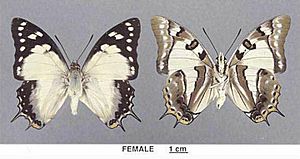Tailed emperor facts for kids
Quick facts for kids Tailed emperor |
|
|---|---|
 |
|
| Mounted female | |
| Scientific classification | |
| Synonyms | |
|
The tailed emperor (Polyura (pyrrhus) sempronius) is a large butterfly found in Australia. Males have a wingspan of about 75 millimeters (3 inches). Females are even bigger, with a wingspan of around 85 millimeters (3.3 inches).
This butterfly lives in many different places across northern and eastern Australia. It prefers warm and subtropical areas near the coast. The tailed emperor stays in areas where its food plants grow naturally. These plants include certain types of legumes and kurrajong trees.
Contents
What it Looks Like
Caterpillar Stage
The caterpillar of the tailed emperor is green when it's fully grown. It's quite special among Australian butterfly caterpillars. It has a yellow line running along each side of its body. Its back also has one or more crescent shapes. The caterpillar's green head has two pairs of long horns. There's also a smaller set of horns behind its head.
Adult Butterfly
The top side of the adult butterfly's wings is boldly marked with black and white. The edges of the wings are a narrow blue-grey color. You can also see small orange spots on the back wings. The butterfly gets its name from the two pointed tails on each of its hindwings.
The underside of the wings looks different for both male and female butterflies. It has complex patterns of red and yellow-brown colors on a white background. These patterns are outlined in black, and the hindwing has an orange edge.
Where it Lives
The tailed emperor butterfly used to live only in northern and eastern Australia. But in the 1970s, it started to spread. Now, you might find it in southern New South Wales, Victoria, and eastern South Australia. However, it doesn't always stay in these southern areas.
For the butterfly to live in the south, the winters need to be mild. Also, there must be enough of its food plants available. The butterfly was first seen in Adelaide in 1973. It is still quite rare there.
What it Eats
The caterpillars of the tailed emperor eat the leaves of certain trees. These trees can be native to Australia or introduced from other places.
Native trees they eat include wattles, the Illawarra flame-tree, lacebark (also called white kurrajong), and kurrajong trees. They also eat Celtis species. An introduced tree they like is the black locust, also known as false acacia.
Adult butterflies do not eat leaves. Instead, they might feed on tree sap, rotting fruit, or moisture from animal dung.
How it Behaves
These butterflies are strong and fast flyers. You can often see them during the dry season. Male butterflies like to go to the tops of hills. They claim a spot by perching head-down about 3 meters (10 feet) up in trees. While perching, they move their hindwings up and down.
The tailed emperor can have two or more generations of butterflies born each year.
Gallery
Images for kids
See also
 In Spanish: Polyura sempronius para niños
In Spanish: Polyura sempronius para niños








